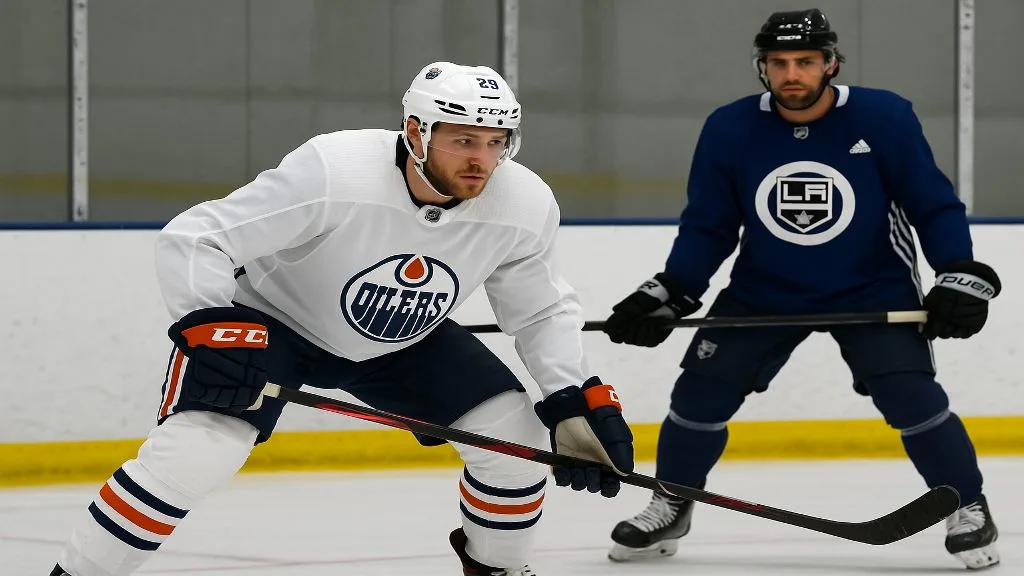Leon Draisaitl has long been defined by elite offense—MVP-level production, ruthless finishing, and power-play orchestration that bends defenses. As the new season dawns, his focus is expanding: he wants to be the forward who dictates the game without the puck as reliably as he detonates it with the puck. That is the heart of his public goal to emulate Anze Kopitar, the Los Angeles Kings captain whose reputation as a model two-way center rests on decades of small, repeatable defensive choices—angles, sticks, body position, and line-driving responsibility.
Draisaitl isn’t abandoning his identity as a scorer; he’s reframing it through the prism of responsibility, where the best offense begins with clean retrievals, won slots, and suffocated exits.
Why Kopitar Is the Gold Standard for Draisaitl
Anze Kopitar’s resume reads like a blueprint for two-way excellence: a pair of Selke Trophies recognizing the NHL’s top defensive forward, leadership through two Stanley Cups, and a career built on minimizing mistakes in high-leverage minutes while still producing at a top-line clip. The Kings captain’s holistic game—faceoff craft, defensive reads, neutral-zone steering, and low-event management late in periods—offers a living syllabus for what Leon Draisaitl wants to bring nightly.
It’s not just the awards; it’s Kopitar’s consistency against top competition and his ability to quiet games at will. Draisaitl has repeatedly cited admiration for that completeness and is setting his sights to reproduce those habits in Edmonton’s top six.
Building a Selke Case in Edmonton’s System
A Selke bid isn’t about one viral backcheck; it’s about season-long proof that your minutes reduce opponent danger. For Leon Draisaitl, that starts with first touches in the defensive zone and ends with controlled exits that flip pressure without icings or hope plays. The Oilers’ structure gives him tools: layers beneath the puck, strong-side support to shorten passes, and a green light to collapse low when the weak-side point threatens the slot.
Add incremental improvements in faceoffs, especially on the penalty kill and defensive-zone draws after icing, and his Selke argument can move beyond reputation into repeatable impact. Edmonton doesn’t need Leon Draisaitl to become a shot-blocking specialist; they need him to make the middle disappear, turn broken plays into clean possessions, and set the tempo of every shift with Kopitar-like calm.
Habits Over Highlights: The Kopitar Checklist Draisaitl Is Chasing
Kopitar’s greatness lives in quiet details that rarely make the reel. Leon Draisaitl is targeting those: arriving early in the slot instead of chipping late, placing the stick blade in passing lanes rather than lunging for picks, owning the dot on defensive-zone draws, and closing the “royal road” with shoulders squared to the middle. He is also prioritizing line changes that don’t strand defensemen, angling on the forecheck that points pucks toward help, and short, honest routes beneath the puck when plays die.
Each micro-habit is a small win that, aggregated across 20 minutes a night, turns into fewer odd-man rushes against and better field position for Edmonton’s transition game. That, in turn, preserves his energy for the offensive bursts that already define his brand.
Leadership Through Defense: How Star Forwards Set the Room’s Standard
When your most gifted scorer is also your most accountable defender, a team’s culture clicks into place. Leon Draisaitl leaning into Kopitar-style responsibility sends a message up and down the forward group: wingers collapse hard to the dots, centers own the middle, and everyone touches the puck on the way out. That shared discipline helps goaltenders see pucks cleanly and lowers the chaos that has occasionally crept into Edmonton’s biggest games.
It also travels—defense is the portable part of a game that wins on the road and in May and June, where whistles fade, matchups tighten, and every turnover carries a tax. The Oilers need their stars to be the standard; Draisaitl trying to win shifts without a point is the kind of standard that wins series.
The Selke Pathway: Metrics and Moments That Matter
Awards voters increasingly blend eye test with indicators: quality-of-competition time, share of defensive-zone draws, on-ice expected goals against, penalty-kill usage, and how often an elite forward’s line tilts the ice at five-on-five. For Leon Draisaitl, the pathway is clear—sustain top-pair matchups, reduce slot chances against, and turn defensive-zone starts into exits instead of scrambles. Short-handed responsibility would further anchor his case.
Add his inevitable top-tier production and a narrative of visible commitment to hard matchups, and he mirrors the way Kopitar constructed his Selke seasons: not by sacrificing offense, but by proving he can put a governor on chaos while still driving results.
Translating Admiration Into Technique: Micro-Adjustments Draisaitl Can Own
Emulating Kopitar doesn’t mean copying stride for stride. It means borrowing concepts and making them Leon Draisaitl own. Expect refined shoulder checks before retrievals to map forecheck pressure, more controlled curls beneath the goal line to buy help time, and deliberate stick positioning that denies the bumper lane on defensive rotations.
Off the rush, watch for early middle-lane coverage that bumps wingers into strong-side angles, and on broken plays, a default to the interior rather than chasing pucks to the boards. These are the tiny decisions Kopitar has automated; Draisaitl adding them to his muscle memory makes everything around him calmer and more predictable.
Why This Matters for the Oilers’ Championship Math
In tight playoff games, your best players must take away the opponent’s best looks. Edmonton’s offense can outpace anyone, but championship math demands fewer goals against in the middle of periods and the final two minutes. If Draisaitl’s line becomes a place where rush chances go to die and cycles stall out, the Oilers gain latitude: defense pairs conserve energy, bench management loosens, and the coaching staff can chase matchups rather than hide them.
The impact compounds across a seven-game series, where half-chances shrink into almost-chances and confidence on the bench grows with every clean exit.
Kopitar’s Legacy as a Living Target
The timing of Leon Draisaitl public admiration intersects with Kopitar entering his final lap, which only sharpens the silhouette of what “complete” looks like at center. Kopitar’s career embodies durability, discipline, and high-IQ hockey—the kind of legacy that gives younger stars a clear, attainable model. For Draisaitl, matching that template is not about eclipsing a legend; it’s about honoring the blueprint by becoming Edmonton’s version of it, night after night, against the league’s best.
That pursuit, and the respect between the two players, underscores how excellence is often a lineage, passed from one master to the next through competition and study.
What Progress Will Look Like Month to Month
If the initiative sticks, you’ll notice quiet shifts: fewer long changes trapped in the zone, more controlled chips that Edmonton can skate onto, and late-game minutes where Draisaitl’s line bleeds the clock with low-risk touches. The penalty kill might also feature him more prominently, both to win draws and to turn clears into short-handed looks that force opponents to think twice at the blue line.
By midseason, the conversation becomes less about “trying to emulate Kopitar” and more about how Draisaitl’s line drives suppression while still racking up points—a subtle but crucial framing that voters, teammates, and opponents all recognize.
The Endgame: A Selke-Caliber Leon Draisaitl Elevates Everyone
The most dangerous version of the Oilers is the one where Leon Draisaitl jaw-dropping offense lives inside a Kopitar-like shell of reliability. That version shortens losing streaks, stabilizes road periods, and mutes the volatility that can flip playoff series. It also frees Connor McDavid to take more aggressive offensive shifts when matchups allow, knowing the team’s other superstar is simultaneously neutralizing top lines.
In that sense, Leon Draisaitl defensive masterclass is not a personal rebrand—it’s a roster multiplier. If he succeeds, Edmonton’s ceiling doesn’t just rise; it hardens, becoming the kind of structure that withstands the grind of spring hockey and gives the Oilers the best possible chance to end their wait for the Cup.







